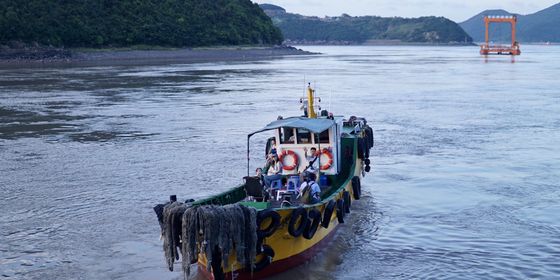As China’s space program sets its sights on the Red Planet, a barren desert in Qinghai is becoming an oasis for simulated space travel
The scorching sands of the Mangnai Desert stretch as far as my eyes can see. An asphalt road runs like a lonely black strip through the sands, which is coarse with stones and salt strewn over the top like a thin layer of snow. A small road veers off into the desert—that is where I need to go.
If not for Baidu Maps, I would never have noticed this nondescript path. It is only made up of tire tracks from previous adventurers, lined with brown crystal formations that peek out of the bleached sand. I can smell the unique chemistry of this place and sense the alkaline air slowly spreading tiny crystals all over the road, tinting my dark backpack and sneakers whitish-yellow as I traverse. From this primitive intersection, I can see no buildings or other signs of life.
The day before I’d ridden my motorbike across the 4,500-meter high Dangjin Mountain Pass from Gansu province to the Tibetan plateau. The gas station employees at a crossroads just outside Lenghu (“Cold Lake”), an abandoned oil colony in the Qaidam Basin of western Qinghai province, told me that further down the road there’s a “Mars Camp” in the middle of the desert. It is said to be one of the few places on Earth that most closely resemble conditions on Mars—I had to check it out.
This is one of the remotest places in China, an area usually avoided by casual travelers and tourists. It is virtually uninhabited, and 250 kilometers from the nearest city of Dunhuang in Gansu province. But for China’s up-and-coming space tourism industry, these forbidding conditions are ideal. “We can get a whole group of up to 50 tourists who will stay here for several days,” says Yang Ruo, a caretaker at Lenghu Mars Camp, the space simulation base 50 meters south of the oil enclave, which offers a chance for civilians to experience life on a potential future space colony on the Red Planet.
Covering over 5 hectares of desert, Mars Camp comprises living quarters mostly constructed from discarded shipping containers made of steel. From above, the individual capsules where guests sleep look like a network of interlocking portable segments running along the sand to the education center at the entrance. On the hills above the camp, I can see a forest of rocks nicknamed the “City of Ghosts”—not only because of the howls the wind makes as it forces its way through the gaps between boulders, but also in memory of the travelers who never made it through this harsh terrain.













